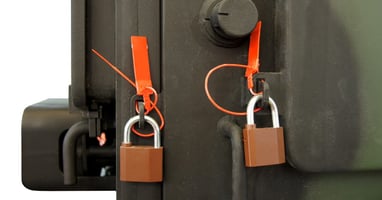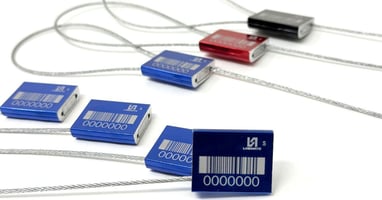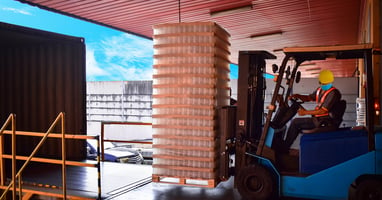In many industries, business success hinges on security. Whether you’re manufacturing goods,...
10 Ways To Protect Your Cargo From Thieves

Theft is always a possibility when shipping large cargo. Fleet managers and logistics professionals find this especially concerning because thievery can be a persistent and costly threat to business.
Arming yourself with effective ways to protect your cargo from thieves can prevent or lessen these incidents. Learn strategies ahead to ensure your safety and security measures will better protect your future cargo.
1. GPS Tracking Systems
Incorporating GPS tracking into your fleet is a game changer. These systems offer real-time location tracking so you can monitor your cargo’s movement around the clock. This capability enhances your fleet visibility and acts as a deterrent to potential thieves who are aware their movements are being tracked.
Implementing GPS tracking means you can respond swiftly to unusual activities or deviations from planned routes. This immediate response can prevent theft before it occurs. Additionally, GPS data can be invaluable if a theft does happen, as it can provide crucial information to law enforcement for recovery efforts.
2. Surveillance Cameras
Surveillance cameras are an extra layer of security. These cameras capture detailed footage that can deter theft and provide evidence if a crime occurs. Placing cameras at strategic points around your warehouse and within vehicles enhances visibility and monitoring capabilities. The mere presence of cameras can discourage thieves from targeting your cargo.
Investing in high-quality cameras ensures you capture clear images and videos to identify culprits and recover stolen goods. Additionally, integrating your surveillance system with mobile and desktop apps allows you to use remote monitoring for your peace of mind, even when you’re off-site.
3. Security Personnel

Employing trained security personnel adds a human element to your security measures. These professionals respond quickly to suspicious activities and manage security technology so everything runs smoothly. Their presence can be a strong deterrent to potential thieves who prefer to avoid human confrontation.
Security personnel protect your cargo and oversee other safety procedures, such as access control and vehicle inspections. They can detect and thwart theft attempts before they escalate by conducting regular patrols and monitoring live surveillance feeds.
4. Secure Packaging
Secure packaging is an often-overlooked aspect of cargo protection. Implementing tamper-proof packaging that’s difficult to open or reseal without detection will deter thieves who usually seek quick and easy targets.
Consider using reinforced materials to fortify your packages. Clear labeling minimizes mishandling; exceptional sealing methods also help. Prioritizing secure packaging protects your shipment contents and increases customer confidence, as they know their orders will arrive intact and on time.
5. Security Seals
Using plastic security seals can deter theft by providing a clear indication if tampering has occurred. You can then instantly identify compromised shipments and put a stop to them if possible. Once a seal is broken, it cannot be repaired or replaced without detection, making cargo less attractive to thieves.
Security seals come in various materials and strengths depending on your specific needs. From bolt seals for containers to cable seals for trucks, these affordable tools offer an added layer of protection and accountability. Further, security seals simplify tracking and inventory processes by providing unique identifiers for each shipment.
6. Employee Training
Properly trained employees are your first line of defense against cargo theft. A well-trained team is an asset to any organization and capable of safeguarding both cargo and company reputation.
Comprehensive training programs should cover critical topics like recognizing suspicious behavior, handling security breaches, and the importance of following security protocols. Well-informed employees can take proactive steps to prevent theft.
Regularly updating training materials ensures your staff stays current with the latest security practices and threats. Encourage a culture of awareness and diligence by rewarding employees who demonstrate exceptional commitment to security.
7. Access Control Systems
Implementing access control systems regulate who has entry to your facilities and vehicles. These systems allow you to assign permissions based on role, ensuring only authorized personnel have access to sensitive areas. Limiting access reduces the chances of internal theft and unauthorized tampering.
Access control systems integrate with other security technologies, such as surveillance cameras and alarms, to provide a comprehensive security solution. Real-time monitoring and reporting features enable you to track personnel movements and respond swiftly to breaches. In a world where insider threats are all too real, access control offers peace of mind.
8. Route Optimization and Planning
Optimizing and strategically planning your delivery routes can reduce the risk of cargo theft. Choosing safer, less congested routes and varying delivery times minimizes the chances of being targeted by thieves who monitor regular patterns. Advanced route planning software can automate this process.
Maintaining a degree of unpredictability in your operations helps you stay one step ahead of potential criminals. Additionally, sharing route plans only with those who need to know further reduces the likelihood of leaks or collusion. A well-planned route will enhance security, improve fuel efficiency, and elevate customer satisfaction.
9. Cargo Insurance
Cargo insurance is an excellent safety net. Insurance provides financial protection in case of theft, ensuring your business can recover losses and continue operations smoothly.
If you’re considering insurance, choose a policy that covers various scenarios, from theft to accidents and natural disasters. Work with a reputable insurance provider who tailors coverage for your specific needs and risks. Regularly review your policy to ensure it evolves with your business requirements.
10. Regular Audits and Inspections

Conducting regular audits and inspections maintains security standards and identifies vulnerabilities. These evaluations assess existing security measure efficiency and identify areas for improvement. Proactively addressing weaknesses prevents theft before it occurs.
Inspections should cover all aspects of your operations, from employee compliance to technological efficacy. Engaging third-party auditors can provide an unbiased perspective and valuable insights.
When it comes to logistics and transportation in the business world, you must have a plan to protect your cargo from thieves. Remember, implementing multiple security measures and having layers of protection is your best bet to thwart thieves.
Consider Logimate if you’re looking for high-quality security seals. We’re a reliable partner your business can trust to protect your cargo better. Explore our products to find what you need or give us a call so we can answer any questions you may have. Keep Logimate in mind for the best cargo security.




